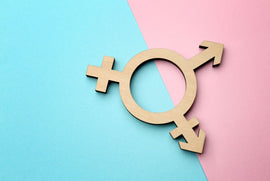We are aware that by trying to describe other cultures, using Western terminology and references, you can end up missing the point.
We’ve done our best to accurately portray each of the following cultures using the resources that are available in English, but if you feel we’ve missed something. Please let us know in the comments below.
Two-spirit, North America
Two-spirit is the word given to describe a traditional social and ceremonial role found in Indigenous Tribes throughout North America.
Two-Spirit is the English translation of an Ojibwe word (niizh manidoowag), since it refers to someone who has a connection to both genders, non-binary would be the closest equivalent.
Many indigenous tribes believe that people who are two-spirits have both male and female spirits. The term encompasses a persons sexual orientation, spiritual role, societal roll and gender roll.
The term two-spirit was adopted in 1990 at the third annual Native American Gay and Lesbian Gathering in Winnipeg, where they decided it was the most appropriate English equivalent to encompass all of the words used by different tribes.
Find out more about Two-Spirit people
Fa’afafine & Fa'afatama, Samoa
In Samoa, the term Fa’afafine and & Fa'afatama is used to describe people outside of the gender binary. Around 1-5% of people in Samoa identify as fa’afafine or fa'afatama
Fa’afafine refers to trans women and fa'afatama refers to trans men.
The terms were first discovered by westerners in the early 20th Century but it has existed in Samoan society for much longer. In Samoan culture fa’afafine and fa'afatama people have been accepted for generations, but growing religious conservatism in the country is threatening the community.
Find out more about fa'afafine and fa'afatama people
Burrnesha, Albania
The burrnesha is the term used to describe a group of AFAB people living as men in Albania. Burrnesha are often called Sworn Virgins by the western media who are quick to dismiss the identity of the burrnesha as a dying tradition of societal necessity.
Many articles and videos online tend to paint the burrnesha as having assumed this role in two instances, firstly, when all members of a family were AFAB, and secondly, as a means to refuse a marriage proposal.
While this may be true for some burrnesha, others have told journalists that they did not have without any societal pressures influencing them; their life is what that they wanted and they live happy and fulfilled lives.
Since coverage of the burrnesha often seems biased at best I suggest reading this article: A Heavy Word: Discourses on Albanian Sworn Virgins from the East European Journal of Feminist and Queer studies, written by a queer Albanian person.
Kinnar/Kinner or Hijra, South Asia
In India and other countries in South Asia, the Kinnar/Kinner or Hijra community have been recognised for centuries. Kinnar or Kinner is preferred by many trans people across the continent and it comes from the word Kinnara/Kinnari, meaning musical celestial beings.
Kinnar/Kinner people are trans and intersex people who are legally recognised by the Indian, Bangladeshi and Pakistani governments.
British colonialists criminalised the community from 1871 onwards, this was repealed when India gained independence however they continue to face extreme discrimination today.
Find out more about Kinnar/Kinner people
Bugis, Indonesia
The Bugis people are the third largest ethnic group in South Sulawesi, Indonesia. They are comprised of 5 gender identities - makkunrai, oroané, bissu, calabai, and calalai. Each is considered essential to the maintenance of balance and harmony in Bugis society.
Using English and western gender ideas, Oroané are comparable to cisgender men, makkunrai to cisgender women, calalai to trans men, and calabai to trans women, while bissu are androgynous or intersex and are revered shamans or community priests.
They are muslim but follow pre-islamic traditions which view gender as a spectrum.
Find out more about Bugis culture
Meti, Nepal
Meti is the Nepalese term for third gender people. The meti are generally femme presenting AMAB people but there are also transmasc meti.
Since 2007, meti has been legally recognised as a gender and people are able to self-identify as meti on their ID.
Despite legal recognition, the meti often face discrimination, marginalisation and persecution.
Find out more about Meti people in Nepal
We would like to continue to update this post adding cultures we have missed. Let us know in the comments if you know of a culture you think we should add.
Wow! This speaks to the further damage that colonialism has caused on a global scale I never knew existed.





Comments